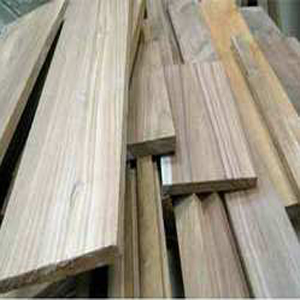

Burma Teak is one of the world's best-known hardwood timbers. Teak is famous for its marine applications, including boat building, and a wide variety of decorative uses.
Teak's heartwood is typically golden brown in colour, although grey and red tinges are not uncommon. The sapwood, a pale yellow colour, is clearly distinct. Grain is usually straight, but due to Teak's high degree of ring porosity, longitudinal streaks and an uneven texture, ranging from coarse to smooth, are typical. The freshly cut wood can be variable in colour, with blotches and streaks, but prolonged exposure to light ameliorates the more extreme variations. Teak contains an oleoresin which gives the timber a greasy feel, and imparts a distinctive odour to freshly cut material.
Teak is a firm timber, in general easily worked. However, the timber's relatively high silica content causes severe blunting of cutting edges. For this reason, the use of tungsten-carbide blades is recommended. Teak holds nails and screws well, although pre-boring is recommended when nailing. Gluing sometimes presents difficulties because of the oily nature of the wood, and it is important to bond only freshly dressed surfaces. Teak will readily accept paints and stains. It also varnishes, polishes and waxes well. It is not suitable for steam bending. Sanding dust irritates the skin of some users.
Teak is well known for its above ground durability, with a life expectancy of greater than 40 years. In-ground life expectancy ranges from 15 to 25 years. Teak exhibits a good resistance to acids, and will not corrode metal fixings. Teak is termite-resistant, although untreated sapwood is susceptible to borer attack.
Teak is extensively used in boatbuilding for decking, rails, bulwarks, hatches, weather doors, and planking. It is also used for cooperage, pipes, and chemical vats. In general construction it is suitable for flooring, decking, framing, cladding, fascias and barge boards. Decorative uses of Teak include indoor and outdoor furniture, parquetry, turnery, carving, lining and paneling.
Teak occurs naturally in the monsoon forests of India, Myanmar, Thailand and Vietnam. Teak plantations have been established in Indonesia, Papua New Guinea, Africa, Solomon Islands, Fiji and the West Indies.
Botanical Name: Tectonagrandis
Preferred Common Name: Teak
Appearance: The heartwood of Teak is typically golden brown in colour, although grey and red tinges are not uncommon. The sapwood, a pale yellow, is visually distinct. Due to Teak's high degree of ring porosity, longitudinal streaks and an uneven grain texture, ranging from coarse to smooth, are commonly present.
Common Applications: Perhaps best known for its use in boat building, Teak has been extensively used for decking, rails, bulwarks, hatches, weather doors, and planking. It is also used for cooperage, pipes, and chemical vats. In general construction it is suitable for flooring, decking, framing, cladding, fascias and barge boards. Decorative uses of Teak include indoor and outdoor furniture, parquetry, turnery, carving, lining and paneling..
Workability: Teak is usually relatively easy to work but silica can be present and this will necessitate frequent sharpening of tools. It peels easily and nails satisfactorily but gluing sometimes presents difficulties because of the oily nature of the wood. It is important to have freshly dressed surfaces. Good resistance to acids. Not corrosive to metal fixings. Unsuitable for steam bending because of excessive buckling. Sanding dust is irritating to the skin for some people. White inclusions of calcium oxalate sometimes appear as flecks in the vessels, lowering the value of veneer thus affected.
Decking: Timber decking creates spaces that are functional, practical and aesthetically pleasing. With the right design and care a timber deck will make a valuable addition to any home or business, creating an outdoor living space that will be enjoyed for years to come.
Internal Paneling: Timber paneling creates interiors as warm as they are stylish. Commonly utilising an MDF or plywood substrate, internal timber paneling is natural and versatile and comes as either solid natural timber panels or as sheets of engineered wood products
Pergolas: A timber pergola is a practical, functional and attractive way to extend living and entertainment spaces into the outdoors.
Timber Joinery Products: Timber joinery products offer a classic, unique and stylish touch to any interior design.
Timber Portal Frames: For buildings that require large spans and column free interiors, timber portal frames provide one of the most aesthetically pleasing solutions. Utilising modern engineering technology, portal frame design transforms timber into a highly effective, efficient and economical structural product. This application guide provides a comprehensive overview of the process of using timber in the specification, fabrication and erection of portal frame structures.
